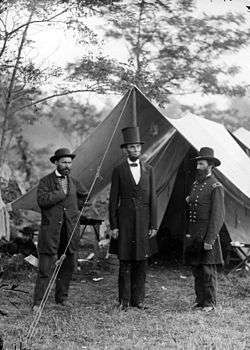American Civil War spies
Tactical or battlefield intelligence became very vital to both armies in the field during the American Civil War. Units of spies and scouts reported directly to the commanders of armies in the field. They provided details on troop movements and strengths. The distinction between spies and scouts was one that had life or death consequences. If a suspect was seized while in disguise and not in his army's uniform, the sentence was often to be hanged. A spy named Will Talbot, a member of the 35th Battalion, Virginia Cavalry, was left behind in Gettysburg after his battalion had passed through the borough on June 26–27, 1863. He was captured, taken to Emmitsburg, Maryland, and executed on orders of Brig. Gen. John Buford.[1]
Confederate Spying
Intelligence gathering for the Confederates was focused on Alexandria, Virginia, and the surrounding area.
Thomas Jordan created a network of agents that included Rose O'Neal Greenhow.[2][3] Greenhow delivered reports to Jordan via the “Secret Line,” the name for the system used to get letters, intelligence reports, and other documents across the Potomac and Rappahannock rivers to Confederate officials.
The Confederacy’s Signal Corps was devoted primarily to communications and intercepts, but it also included a covert agency called the Confederate Secret Service Bureau, which ran espionage and counter-espionage operations in the North including two networks in Washington.[4]
Confederate Spies
- Joseph Baden[5]
- John Yates Beall
- Belle Boyd
- William Bryant[6][7]
- James Dunwoody Bulloch
- Confederate Secret Service
- David Owen Dodd
- Nancy Hart Douglas
- Zora Fair
- Antonia Ford
- Rose O'Neal Greenhow
- Thomas Harbin[8]
- Henry Thomas Harrison
- Elizabeth Carraway Howland
- Annie Jones
- Thomas A. Jones[9]
- Thomas Jordan
- Alexander Keith, Jr.
- Virginia Bethel Moon
- Samuel Mudd
- William Norris
- Emeline Piggott
- Sarah Slater[10][11]
- Richard Thomas (Zarvona)
Union Spying

The Union's intelligence gathering initiatives were decentralized. Allan Pinkerton worked for Maj. Gen. George B. McClellan and created the United States Secret Service.[4] Lafayette C. Baker conducted intelligence and security work for Lieutenant General Winfield Scott, commander-in-chief of the U.S. Army. President Abraham Lincoln hired William Alvin Lloyd to spy in the South and report to Lincoln directly.[4]
As a brigadier general in Missouri, Ulysses S. Grant was ordered by Maj. Gen. John C. Frémont to start an intelligence organization.[4] Grant came to understand the power of intelligence and later put Brig. Gen. Grenville M. Dodge as the head of his intelligence operations that covered an area from Mississippi to Georgia with as many as one hundred secret agents.[4]
Maj. Gen. Joseph Hooker, who became commander of the Army of the Potomac in January 1863, ordered his deputy provost marshal, Col. George H. Sharpe, to create a unit to gather intelligence. Sharpe set up what he called the Bureau of Military Information and was aided by John C. Babcock, who had worked for Allan Pinkerton and had made maps for George B. McClellan. Sharpe’s bureau produced reports based on information collected from agents, prisoners of war, refugees, Southern newspapers, documents retrieved from battlefield corpses, and other sources. When Grant began his siege of Petersburg in June 1864, Sharpe had become Grant’s intelligence chief.[4]
The most useful military intelligence of the American Civil War was probably provided to Union officers by slaves and smugglers.[12] Intelligence provided by slaves and blacks were called black dispatches.[13]
Union Spies
References
- ↑ Fishel (1996). The Secret War for The Union.
- ↑ Harnett, Kane T. (1954). Spies for the Blue and the Gray. Hanover House. pp. 27–29.
- ↑ Markle, Donald E. (1994). Spies and Spymasters of the Civil War. Hippocrene Books. p. 2. ISBN 078180227X.
- 1 2 3 4 5 6 United States (2005) Intelligence in the Civil War.
- ↑ Swanson, James L., Manhunt: The 12-Day Chase for Lincoln's Killer. New York, HarperCollins, 2006, p. 258.
- ↑ Swanson, James L., Manhunt: The 12-Day Chase for Lincoln's Killer. New York, HarperCollins, 2006, p. 259.
- ↑ http://rogerjnorton.com/LincolnDiscussionSymposium/thread-1513.html
- ↑ Swanson, James L., Manhunt: The 12-Day Chase for Lincoln's Killer. New York, HarperCollins, 2006, p. 258f.
- ↑ Swanson, James L., Manhunt: The 12-Day Chase for Lincoln's Killer. New York, HarperCollins, 2006.
- ↑ Swanson, James L., Manhunt: The 12-Day Chase for Lincoln's Killer. New York, HarperCollins, 2006, pp.167, 256.
- ↑ "Search".
- ↑ Quarles(1953). The Negro in the Civil War.
- ↑ Rose (1999). Black Dispatches.
Bibliography
- Fishel, E. C., The Secret War for The Union: The Untold Story of Military Intelligence in the Civil War. Boston, Houghton Mifflin Co, 1996. ISBN 0395742811
- Quarles, B., The African American in the Civil War. Boston, Little, Brown, 1953.
- Rose, P. K., Black Dispatches: Black American Contributions to Union Intelligence During the Civil War. Washington, D.C., Center for the Study of Intelligence, Central Intelligence Agency, 1999.
- United States Government, Intelligence in the Civil War. Washington, D.C., Central Intelligence Agency, 2005.
- Swanson, James L., Manhunt: The 12-Day Chase for Lincoln's Killer. New York, HarperCollins, 2006. ISBN 0060518502
Further reading
- Abbott, Karen (2014). Liar, Temptress, Soldier, Spy: Four Women Undercover in the Civil War. Harper, an imprint of HarperCollins Publishers. ISBN 9780062092892. OCLC 878667621.
- Melanson, Philip H.; Stevens, Peter F. (2002). The Secret Service: The Hidden History of an Enigmatic Agency. Carroll & Graf Publishers. ISBN 0786710845. OCLC 50478513.
- Stern, Philip Van Doren (1990). Secret Missions of the Civil War: First-Hand Accounts by Men and Women Who Risked Their Lives in Underground Activities for the North and the South. Bonanza Books. ISBN 0517000024. OCLC 18683019.
- Ryan, Thomas J.; Sears, Stephen W. (2015). Spies, Scouts, and Secrets in the Gettysburg Campaign: How the Critical Role of Intelligence Impacted the Outcome of Lee's Invasion of the North, June-July, 1863. Savas Beatie. ISBN 9781611211788. OCLC 865495253.